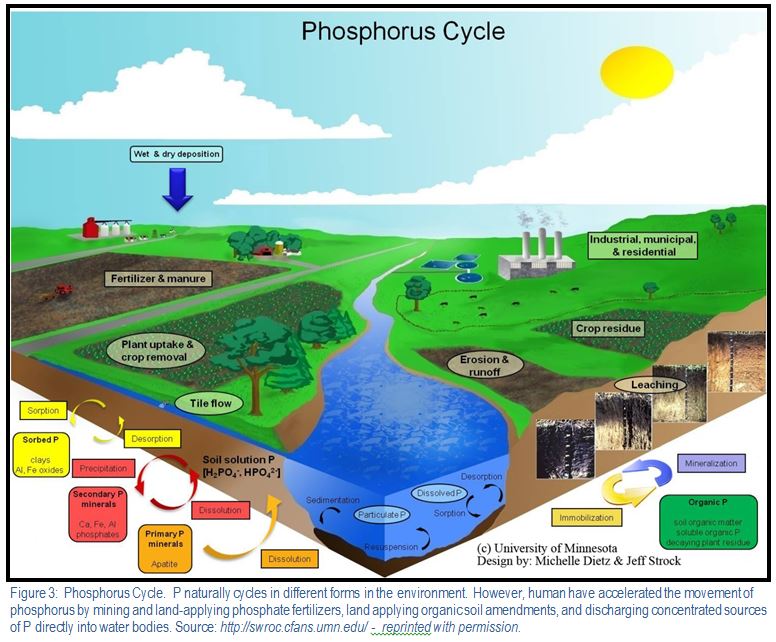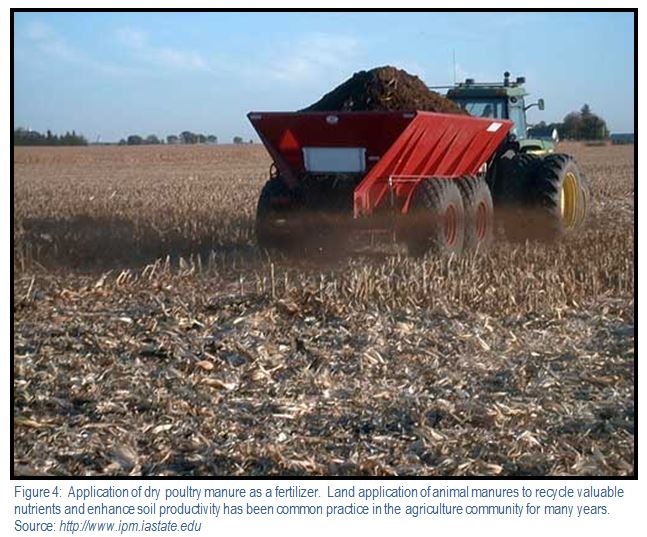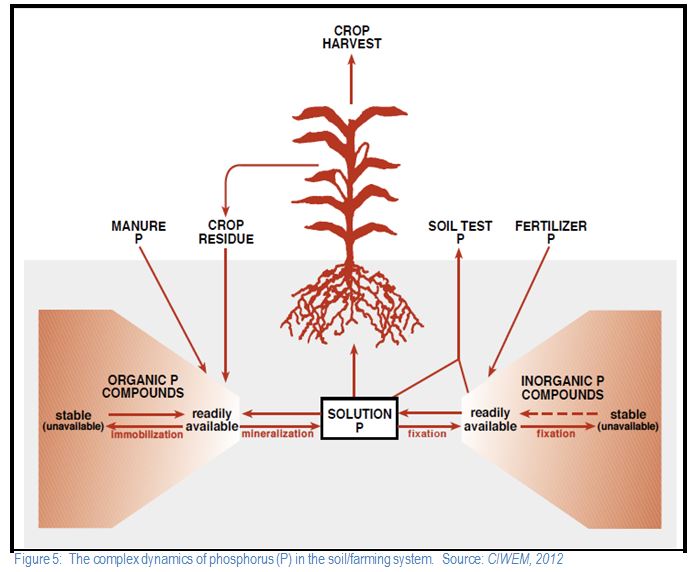Phosphorus (P) is an essential element for life. Most significantly, P is a component of nucleic acids (DNA and RNA), the biological molecules critical for all known forms of life. Phosphorus is also an important element in adenosine diphosphate (ADP) and adenosine triphosphate (ATP), the energy storage and transfer molecules in cells, and it functions as a building block of phosphoproteins and phospholipids, the macromolecules that form cell membranes (Beegle, 2012).
In modern agriculture, P is one of the most critical nutrients for crop and livestock production due to its vital role in root growth and seed (grain) production (Sharpley et al., 2003)(Figure 1). Therefore, an adequate supply of P is essential to maintain and promote optimum crop growth and, in turn, profitable agriculture (PSU, 2007). In fact, without fertilization from P, it is estimated that wheat yields would be reduced by more than half - from four to less than two tons per acre (Soil Association, 2010).

The advent of regionally specialized agriculture (and concentrated animal feeding operations) in the mid-1900s has led to an abundance of phosphorus-rich organic soil amendments (i.e. manure) in some areas, and, in turn, the application of P in excess of crop uptake. This results in an accumulation of P in the soil which, in turn, has the potential to be transported in runoff to surface waters by means of surface runoff and, in course-textured low P-sorbing soils, leaching through the soil profile. Although P applied beyond crop needs will not adversely affect crop yields, nutrient enrichment of surface waters can promote the rapid growth of algae, followed by depletion of dissolved oxygen during algal decomposition (Figure 2). This leads to organic enrichment of the water body, or eutrophication, a natural aging process of surface waters that is accelerated by excess nutrients and increased biological productivity (Carpenter et al., 1998). Eutrophication causes an overall degradation of water quality for aquatic life and for human activities (more costly treatment for drinking water purification, reduced fishing and recreational availability, and reduced aesthetic value). In fact, two of the main causes of eutrophication, organic enrichment and nutrient loading, are cited by the U.S. Environmental Protection Agency (USEPA) as two of the top five leading causes of water quality impairment in U.S. surface waters (U.S. Environmental Protection Agency, 2009). As a result of degraded water quality, especially in prominent national resources such as Chesapeake Bay, nutrient management standards – including new P-based management – have gained increasing traction in recent years.

Phosphorus is widespread in the environment, where it undergoes a natural cycle between plants, animals, rocks, minerals, and water. As depicted in Figure 3, humans have greatly accelerated the natural P cycle by
- mining mineral phosphate rock (the mineral form of P) and converting it to fertilizer,
- land-applying organic soil amendments (i.e. manure and biosolids) in concentrated areas, and
- discharging wastewater directly into surface waters.
Human-induced movement of P into the environment is grouped into two categories; point sources and non-point sources.
A point source is a single identifiable channel, such as a pipe, from which P is discharged. Point sources include discharges (effluent) from water resource recovery facilities (WRRFs), industrial pretreatment facilities, agricultural operations (e.g. confined animal feeding operations (CAFOs)), and municipal and industrial stormwater collection facilities. In recent years, point sources in many states have felt the pressure to reduce discharges of P through substantial reductions in effluent discharge permit limits. Some WRRFs are being required by USEPA and states to reduce P discharges to less than 1 mg/L. In Pennsylvania, for example, prior to 2010, only the largest WWRFs had permitted P discharge limits set at 2.0 mg/L; now the vast majority of WWRFs in the Chesapeake Bay watershed have permitted maximum P discharge limits set at 0.8 mg/L. Although targeting point sources for P management is relatively straightforward with modifications to discharge permits, tightening permit limits does not proportionately improve water quality, because the major source of excess P entering surface waters originates from non-point sources (Parry, R. 1998). In fact, USEPA (2009) identified agricultural nonpoint source pollution as a leading contributor to nutrient pollution of rivers and streams.
Non-point-source P comes from an area(s) with undefined boundaries, and, therefore, management of non-point-source P has proven to be quite challenging. The three major contributors of non-point-source P to surface runoff are soils, plant material, and applied fertilizers, manures, and biosolids (Vadas et al., 2004). Although soil and plant material contribute to runoff P, soil P is primarily environmentally unavailable and plant material contains just a small fraction of the total P in these three sources. As such, environmentally available P is primarily added to the environment via inorganic mineral fertilizers and organic amendments (manures and biosolids).

Because P is one of the three critical macronutrients required for healthy plant growth, it has long been a substantial ingredient in many fertilizers. Most fertilizers are formulated and labeled based on their macronutrient content; for example, a common kind of commercial fertilizer is “10-10-10,” meaning it contains 10% nitrogen (N), 10% phosphate (P2O5), and 10% potash (K2O) by weight.
The commercial source of mineral phosphate is “phosphate rock”, the name given to natural calcium phosphates. Millions of tons of phosphate rock are mined every year for use in mineral phosphate fertilizers (Soil Association, 2010).
Although fertilizers containing mineral phosphate are commonly used across the United States, farmers tend not to over apply P from mineral fertilizers, because doing so is economically impractical (Beegle, 2012). But even when mineral P fertilizers are applied at crop P uptake rates – meaning that the P applied is mostly removed in the crop when the crop is harvested – certain farming practices (i.e. conventional tillage or fertilizer application immediately prior to a precipitation event) have been shown to lead to P transport to ground and surface waters via leaching (particularly in sandy soils) and sediment runoff (Gascho, et al., 1998). Because of this, and because agriculture is a large user of mineral P fertilizers, the U. S. Department of Agriculture (USDA) and other advisors have focused considerable attention over the past two decades on managing P use more carefully, including recommending – and, in many areas, requiring – nutrient management plans that limit P applications.
Mineral phosphate is also widely used in markets independent of conventional feed and fiber agriculture. In some of the more densely populated parts of North America, mineral phosphate fertilizer is commonly applied to turf grass, including parks, sports fields, golf courses, and residential and commercial lawns. In Maryland, for example, it is estimated that 44% of chemical fertilizer sold in the state is used for these purposes (Maryland Dept. of Agriculture, 2013). Due to the challenges of properly managing P in these settings, state laws and regulations have been enacted throughout much of the Northeast that prohibit or significantly limit the use and/or sale of P for lawn maintenance (NEIWPCC, 2012).
Using manure as a fertilizer for crops is common throughout much of North America (Figure 4). Most often, manure is applied to meet the nitrogen (N) needs for the desired yield of the planted crop. Because the N/P ratio of manure (2:1 to 6:1) is lower than that in crop uptake (7:1 to 11:1), N-based manure management results in more P being added to the soil than the crop requires. This results in a buildup of P in soils (Maguire et al., 2002), and in turn, may increase concentration of dissolved P in surface runoff or lateral subsurface flow.
In recent years, the trend towards intensive livestock operations on relatively small areas of land has exacerbated this nutrient imbalance in some areas. In the past, traditional farming practices involved feeding animals with crops grown on the farm and then returning their manures to the fields whence the crops came, thus generally maintaining a balance of nutrients within the farm boundaries. In contrast, today’s concentrated animal feeding operations (CAFOs) import food (nutrients) into relatively small areas where many animals are fattened, resulting in an accumulation of manure and an excess of nutrients in these localized areas (Gburek et al., 2000).

Biosolids, the nutrient-rich organic materials resulting from the treatment of sewage sludge, is used as a fertilizer for feed and fiber crops throughout most of the United States. Traditionally, biosolids are applied to meet the nitrogen (N) needs for the yield goal of the planted crop. As with manures, most biosolids are an “unbalanced” fertilizer: N-based biosolids nutrient management results in the application of P at a rate 5-10 times greater than the crop need (Maguire et al., 2000). In turn, continual application of biosolids to meet crop N needs can noticeably increase total and environmentally available soil P.
It is important to note that although continuous biosolids application can result in an accumulation of soil P, the percent of “labile” (mobile) P in biosolids (24%) is significantly smaller than other amendments (55-70%), and therefore may be less likely to be environmentally available and significant compared with other fertilizers and soil amendments (Ajiboye et al., 2004).
The dynamics of P in soils and the environment are complex, and research continues to advance understanding of this critical aspect of soil chemistry. However, what is known is that the P found in soils consists of a large variety of compounds that make the P either more or less environmentally available, and, therefore, more or less likely to cause undesirable eutrophication of surface waters. But, in general, regulatory agencies charged with protecting surface water quality are concerned when there are high levels of total P in soils adjacent to water bodies.
Soil P exists in organic and inorganic forms, and each form consists of a continuum of many P compounds, existing in equilibrium with each other and ranging from solution P (which can be taken up by plants), to “labile P” (potential to be converted to solution P by microbial action), to very stable compounds (unavailable to plants) (Figure 5). In most soils, 50 to 75% of the P is in the unavailable, inorganic form, meaning it is bound in mineral complexes (Penn State Univ., 2001). There are several factors that influence P dynamics in soil including soil texture, and most notably, pH (Frossard et al., 2000). In soils, P binds strongly to iron and aluminum at mid to low soil pH. At high pH, P binds to calcium. The optimal pH for making P available to plants is 6.5 (Havlin et al., 2004).

As discussed previously, P enters the environment from many sources; fertilizers and soil amendments are some of the larger sources. On agricultural lands, P can be removed from soils via wind erosion, runoff, or, preferably, by crop uptake and removal when harvested.
Concerns about P in soils focus on the potential for transport of P to surface waters. The two most significant pathways of P transport are:
- Dissolved P in stormwater runoff. A variety of studies have found a significant correlation between the concentration of dissolved P in runoff water and the soil P content, as measured by P agronomic soil tests Sharpley, 1995 (see below for information on P test methods).
- P adsorbed in soil particles. This form of P can move to surface water when the soil particles are eroded. According to Penn State University (2001), up to 90% of the P transported from cropland is attached to sediment. Thus, erosion control is of prime importance in minimizing P loss from agricultural land.
Because P adsorbs readily to soil particles, P does not leach downward in significant quantities in most soil types, and, in turn, relatively little P is found in lower soil horizons (Penn State Univ., 2001; Sharpley, 1995). Thus leached P, which can move in shallow groundwater to surface water, is not an important pathway in most situations. If P does not leave a site as dissolved P in surface water runoff, via erosion of sediment containing P, or via plant uptake, it remains in the topsoil, where it tends to become part of increasingly stable mineral complexes. In fact, according to Penn State, up to 90% of inorganic P can become fixed within 2 to 4 weeks of being added to soil (Penn State Univ., 2001).
Similarly, organic forms of P, found in biosolids and manures, are also “fixed” but will slowly become available as microorganisms break down the organic matter. Once transformed into soluble P, soil pH, temperature, soil texture and other factors mentioned below will determine its fate.
Understanding the behavior P in the environment can help farmers meet the P needs of crops while avoiding release of excess P to surface waters (Frossard et al., 2000).
The science is still developing regarding whether or not P that is labile in soil and available to plants, but not readily water soluble, presents a significant risk to surface water quality. According to Kukier et al (2010) it appears that the size of the labile pool of an element in soil does not directly correlate in a simple way into element concentration in plant shoots. A complexity of other factors, such as soil pH, plant physiology, competition between elements for absorption sites at the root surface, element speciation in soil solution, and the kinetics of sorption/desorption and precipitation/dissolution processes, all play a role in the P uptake by plants and the movement of P into the surrounding environment.
Codling (2013) reported that P added to soil via biosolids continues to be available to plants for many years after application. However, others argue that this pool of labile P may be plant available, but it is unlikely to escape the soil system and impact surface water quality (Codling, 2013).
In summary, for phosphorus to adversely impact water quality, it must be present and there must be a method by which it is transported to a surface water body (especially ones that are susceptible to eutrophication). Research has demonstrated that high levels of soil P far from water bodies are, in general, not a threat and soils with low levels of P near susceptible water bodies present little threat (however, ideally, such soils should be managed to avoid build-up of excess P). The risk of P impacts on surface waters increase with higher levels of soil P, proximity of surface waters, and well-defined pathways for transporting soil P to surface waters. These are the factors that are considered in phosphorus indices, tools that help manage the risk of non-point P pollution from agriculture, which are described below.
Assessing the particular potential risk of soil P affecting nearby surface waters depends on measurements of P in the soil. There are several different soil tests for P. They include:
This test involves use of a strong acid to strip as much P as possible from all minerals and molecules to which it is bound. Total P is a poor indicator of the potential for water quality impacts, because, in a field setting, much of the P it measures is bound to soil particles and is not available (i.e. not easily water soluble).
This is the most commonly used measure of P in soil, because it measures the phosphorus that is most likely available for uptake by plants. This includes P that is easily water soluble, as well as some that is less soluble, but labile. There are four standard tests that all aim to measure plant-available P: Bray, Olsen, Mehlich 3, and Modified Morgan. All report P in the P2O5 (phosphate) form, which relates stoichiometrically to Total P in this way: P2O5 = 2.291 * Total P. Most fertilizer recommendations and regulations use this measure of P (i.e. phosphate, P2O5).
The Bray, Olsen, Mehlich 3, and Modified Morgan tests differ in several ways, such as the concentration and makeup of the solution added to extract the P and the amount of time the sample is shaken (Sawyer, 1999). Each was developed to address different agronomic needs; for example, Bray was originally developed for Midwest soils, Mehlich 3 was developed for acidic Southeast soils with low cation exchange capacity (CEC), and Morgan (later modified) was developed as a more universal test for acid soils typical of the Northeast.
All of the above P test methods were developed to assess the level of P in a soil in order to develop recommendations for P fertilizer needs that will ensure best crop growth. But, soil P tests conducted for crop-growing recommendations do not correlate with potential environmental impacts of P to surface waters. Thus, a soil test result indicating an “optimum” level of P for a crop does not necessarily indicate if the level of P in the soil is likely to negatively impact surface water quality or not (Penn State Univ., 2001).
More recent research indicates that the P in biosolids and other materials that is of concern with regards to potential water quality impacts is only that portion of P that is water soluble, known as water extractable P (WEP). The remaining P is adsorbed strongly enough that it is unlikely to run off or leach and affect surface waters. As noted above, some of this P may still be labile (i.e. it may be undergoing transformations from being bound in one compound to being bound in another more plant-available compound) (Chaney, 2013; Chaney and Codling, 2005; Codling et al., 2000), but it is unlikely to escape the soil system and impact water quality. While not completely understood, when biosolids are involved, the reduced availability of P is likely due to the high levels of P binding constituents – such as aluminum or iron – in the typical biosolids. This reduced availability of P in biosolids is now accounted for through P source coefficients used in P indices (see below).
When regulations and best practices are developed, the type of test used to measure P is a critical consideration. Currently, different jurisdictions require different test procedures, resulting in significantly different restrictions on rates of application of P in various fertilizers and soil amendments.



